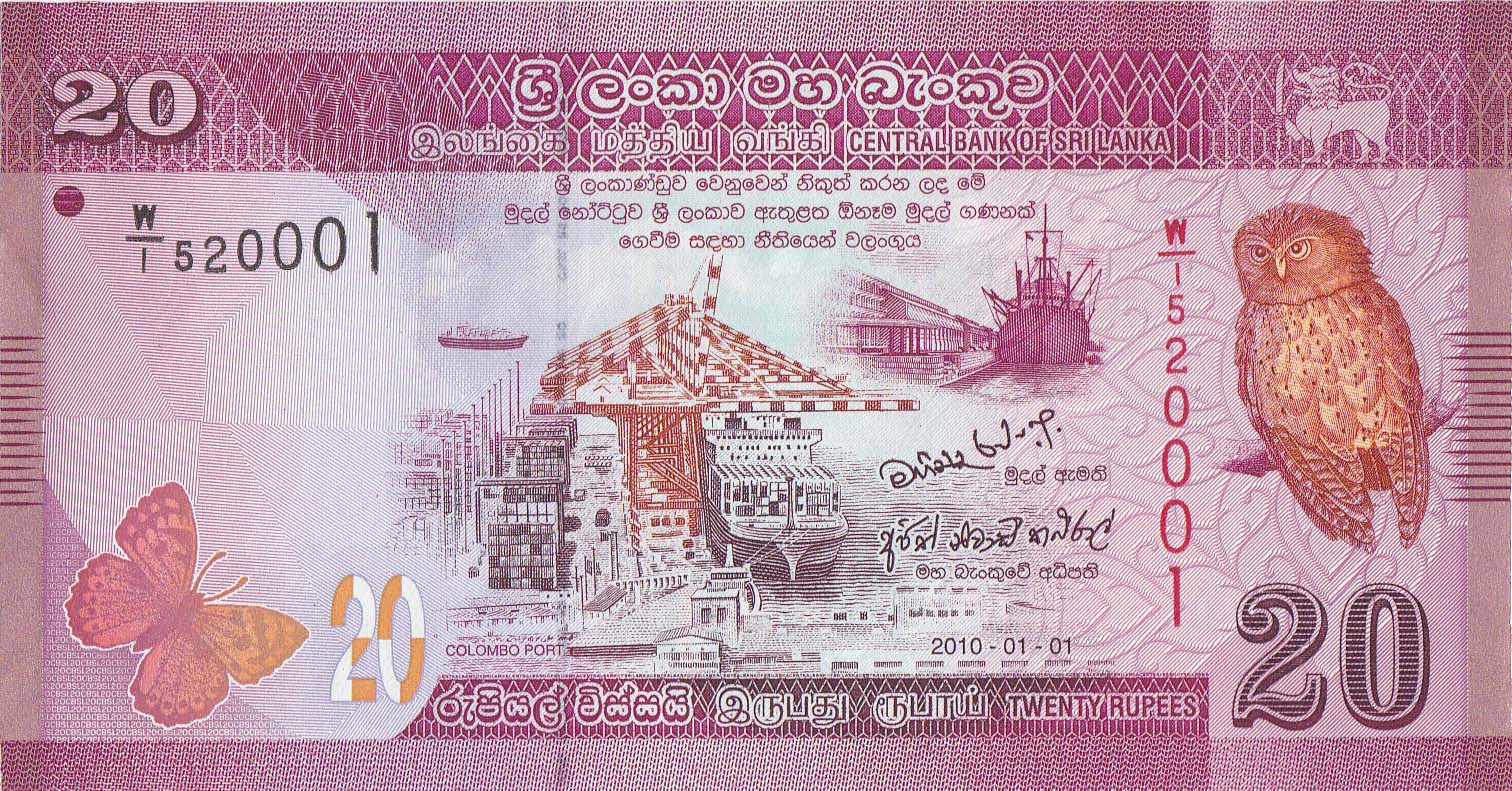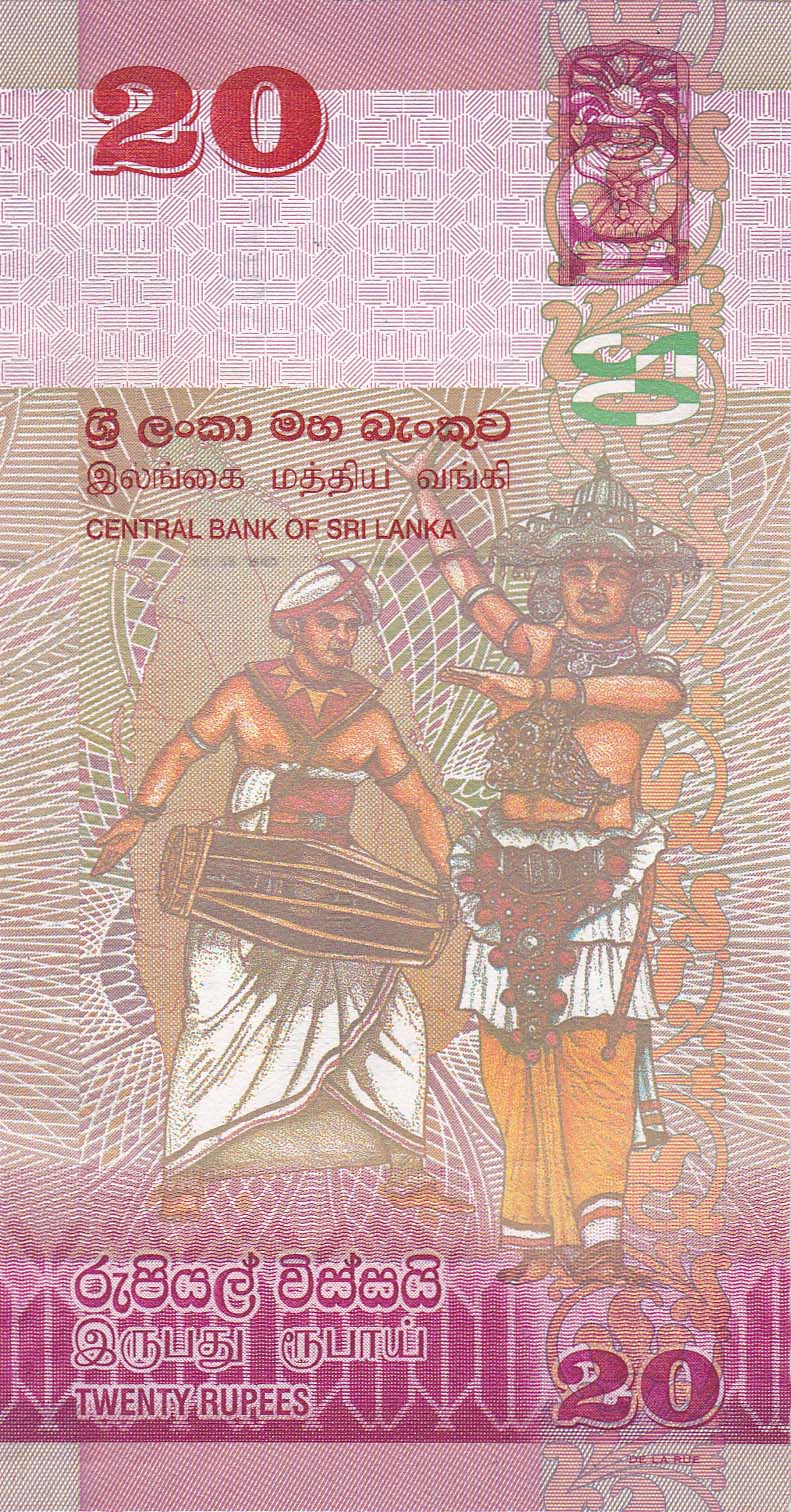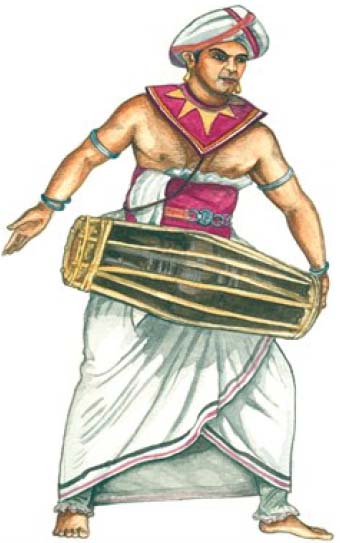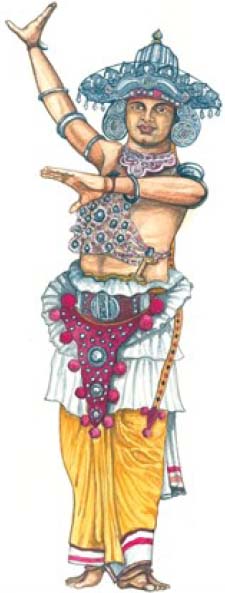

Front: Landscape
An artist's impression of a recent view of the COLOMBO PORT with an early view of the Port to upper right.
Illustrated are the Sri Lanka bird Serendib Scops Owl to the right, and the butterfly, the Baronet to the lower left.


| 
|
| Click image to see Note Security under UltraViolet illumination Front: Landscape An artist's impression of a recent view of the COLOMBO PORT with an early view of the Port to upper right. Illustrated are the Sri Lanka bird Serendib Scops Owl to the right, and the butterfly, the Baronet to the lower left. |
 ශ්රී ලංකා මහ බැංකුව
in Sinhala,
இலங்கை மத்திய வங்கி in Thamil
and CENTRAL BANK OF SRI LANKA in English,
in 3 lines of decresing font size, at center upper left.
ශ්රී ලංකා මහ බැංකුව
in Sinhala,
இலங்கை மத்திய வங்கி in Thamil
and CENTRAL BANK OF SRI LANKA in English,
in 3 lines of decresing font size, at center upper left. Latent image: Right of the top left numeric on front, the
Numeric value 20 written italic with horizontal lines on
a vertical lines background, both slightly tilted clockwise, as seen
on this 1200 dpi scan on right.
Image also show microprinting array of text CBSL.
Latent image: Right of the top left numeric on front, the
Numeric value 20 written italic with horizontal lines on
a vertical lines background, both slightly tilted clockwise, as seen
on this 1200 dpi scan on right.
Image also show microprinting array of text CBSL.
| Predominant Color | : Maroon | | | Size | : 128 x 67 mm |
| Serial Prefix | : W | | | Replacement Prefix | : Z/2, Z/3, Z/10 |
| Florescent Fiber | : Yellow | | | Braille | : One Dot |
Front Landscape both old and New, with endemic Bird and Butterfly designed by by Artist Mr Kelum Gunasekara. Back portrait of traditional Sri Lankan drummer and a dancer designed by Artist Sisira Liyanaarachchi.
| Date on BankNote | Finance Minister | CBSL Governor | First Serial # | Last Serial # | Mintage in K | Replacement Prefix |
| 2010-01-01 | Mahinda Rajapaksa | Ajith Nivard Cabraal | W/1 000K | W/180 1000K | 180,000 | Z/2 |
| 2010-01-01 | Mahinda Rajapaksa | Ajith Nivard Cabraal | W/181 000K | W/280 1000K | 100,000 | Z/2 |
| 2015-02-04 | Ravi Karunanayake | A. Mahendran | W/281 000K | W/310 1000K | 130,000 | Z/2 |
| 2015-02-04 | Ravi Karunanayake | A. Mahendran | W/311 000K | W/315 1000K | 4,000 | Z/3 |
| 2015-02-04 | Ravi Karunanayake | A. Mahendran | W/316 000K | W/410 1000K | 95,000 | Z/10 |
| 2016-07-04 | Ravi Karunanayake | I. Coomaraswamy | W/411 000K | W/495 1000K | 85,000 | Z/10 |
| 2017-05-22 | Mangala Samaraweera | I. Coomaraswamy | W/496 000K | W/578 1000K | 75,000 | SNIM-10.7% |
| 2019-12-24 | Mahinda Rajapaksa | W. D. Lakshman | W/579 000K | W/611 399K | 30,000 | SNIM-10.8% |
| 2020-08-12 | Mahinda Rajapaksa | W. D. Lakshman | W/611 400K | W/644 879K | 30.000 | SNIM-11.6% |
| 2021-09-15 | Basil Rajapaksa | Ajith Nivard Cabraal | W/644 880K | W/724 750K | 75,600 | SNIM-5.6% |
| 2022-07-04 | Ranil Wickremesinghe | Nandalal Weerasinghe | W/725 000K | W/788 450K | 60,000 | SNIM-5.8% |
A second order of 45 Million notes have been ordered of Rupees 20
notes has been placed with DeLaRue in 2024. (Reply to RTI 122/2024)
End prefix estimated about W/837 assuming 8% damage rate.
UV cured Post Print Varnish (UVPPV) coating was applied on Rs. 100/-
currency notes after 2014 from W/181 onwards and these notes are
slightly thicker. (CBSL Webpage)
With or without the use of Replacement the First and Last serial is not known to the last digit as it could be a replacement or rejected. It is given to the First or last Brick (1000 or K notes)
From W/496 SNIM (Single Note Inspection Machine) was used. Error notes
removed, but not replaced with Z serial Replacements. Packs have
missing serial numbers.
The First Rs20 note in this series was reported in circulation in 2020
March 12th almost 3 years after date on banknote just before COVID-19 lockdown.
In a new brick 1000 W/508 Rs 20 notes with date 2017-05-22 packed on
2018-01-20, I found 83 missing serial numbers on 2020-06-02.
There was 2 series separated by about 199,200 in the Bundle. Few Notes were in a
different bundle of 100 from which they were found.
Most missing notes were singles, there were 5 pairs, 1 triple, and 1 quad to total the 83.
Harry Gunawardena gave me a bundle of 100 Rs20 notes dated 2019-12-24
which also had 2 series, which were not even of the same prefix.
W/580 105433 to W/580 105497 Missing two 59 76 and then
W/586 112001 to W/586 112035 Missing one 10. How does printed notes
get loaded to SNIM so randomly to get such a difference 6,006,504.
Serial number printing must be sequential, With 40 notes per sheet
each print run will generate 40 bundles. These bundles may not get
loaded into SNIM in sequence. After checking SNIM will count and make
100 packs with a paper strap and then wrap 10 of these paper packs
into a 1000 bundle with plastic strap with CBSL logo.
Please Help Track Prefix+Serial when Date on Banknote change. Thanks.
Mintage of 75M notes stated in reply to RTI 0001/2020 is 8M (10.67%) less than the difference of Last - First Serial for this issue. The increase of error rate from 0.2-0.3% replacements to about 10% missing serial numbers with the adoption of SNIM by DeLaRue is explained by more stringent quality control, but mainly because, printed sheets are not quality checked before printing Serials.
The note scanned at 300 dpi and displayed above at 50 dpi
Port of Colombo
The Port of Colombo is the largest port in Sri Lanka at present. It
serves as a major seaport in Asia due to its unique location in the
Indian Ocean. The port was built in the early 14th century during the
Kotte kingdom and was known as Port of Kolomtota. The Port of Colombo
is administrated by the Sri Lanka Ports Authority.
Serendib Scops Owl - Otus thilohoffmanni
Sri Lanka Pandukan Bassa/Panduwan Bassa (Sinhala),
Ilangai Serandib Sevi Aandhai (Tamil)
Serendib Scops Owl is an endemic owl species identified in 2004,
restricted to the low country wet zone of Sri Lanka. This species is
categorized as endangered by the International Union for Conservation
of Nature (IUCN) due to habitat loss and degradation.
The Baronet - Symphaedra nais
Nilgala Samanalaya (Sinhala)
Baronets are magnificently coloured butterflies with an orange upper
side marked with black streaks and white edging on their wings. Their
underside is reddish brown. The species is mostly found in the south
central and south eastern part of the island.
Punkalasa Guard stone
Guardstones (doratupala figures or muragal) are one of
the finest creations of ancient Sinhalese artwork. Guard stone carved
with pot of plenty is an expression of prosperity and it is associated
with the belief of ushering prosperity to the building throughout the
year. The best example of a guard stone with a pot of plenty is seen
at the Abhayagiri archeological complex.
Liya Vela
Liya vela is a commonly used design technique in Sinhala
art. It is a decorative art form using the leaves and flowers of a
creeper.

 Ves Netuma
Ves Netuma
Ves Netuma (Ves Dance), the most popular form of dance in Sri
Lanka, belongs to the classical dance known as Kandyan Dancing. It is
believed that the Kandyan Dance originated in the 4th century BCE with
the ritual known as the Kohomba Kankariya, which Is performed to
propitiate the deity known as Kohomba to obtain relief from
various sicknesses, pestllences and to ensure health and prosperity
throughout the year. The elaborate costume comprises of its glorious
head dress which is considered sacred, a skirt like trilled cloth,
decorated chest plates and bangles for arms and ankles. The Ves
Netuma originally confined to the ritual of the Kohomba
Kankariya, now forms a part of the repertoire of Kandyan Dancing
and is performed on stage and in the Kandy Perehera independent of its
ritual significance. The main drum used for this form of dance is the
Geta Beraya
Geta Beraya
Geta Beraya (Kandyan Drum) is the main drum used n Kandyan
Dancing tradition, The drum tapers from the centre towards the ends.
Text edited from Press Releases of the CBSL.
For collected details of the images on this Banknote see
NotesCollector.